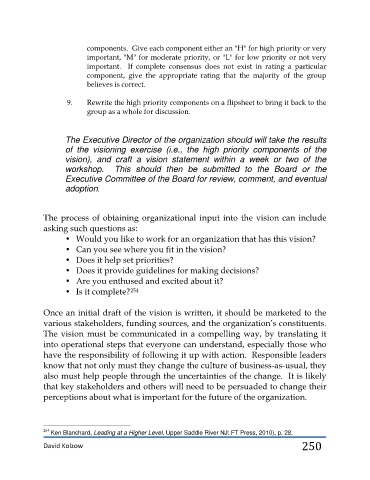Page 250 - 4- Leading_from_Within
P. 250
components. Give each component either an "H" for high priority or very
important, "M" for moderate priority, or "L" for low priority or not very
important. If complete consensus does not exist in rating a particular
component, give the appropriate rating that the majority of the group
believes is correct.
9. Rewrite the high priority components on a flipsheet to bring it back to the
group as a whole for discussion.
The Executive Director of the organization should will take the results
of the visioning exercise (i.e., the high priority components of the
vision), and craft a vision statement within a week or two of the
workshop. This should then be submitted to the Board or the
Executive Committee of the Board for review, comment, and eventual
adoption.
The process of obtaining organizational input into the vision can include
asking such questions as:
• Would you like to work for an organization that has this vision?
• Can you see where you fit in the vision?
• Does it help set priorities?
• Does it provide guidelines for making decisions?
• Are you enthused and excited about it?
• Is it complete? 254
Once an initial draft of the vision is written, it should be marketed to the
various stakeholders, funding sources, and the organization’s constituents.
The vision must be communicated in a compelling way, by translating it
into operational steps that everyone can understand, especially those who
have the responsibility of following it up with action. Responsible leaders
know that not only must they change the culture of business-as-usual, they
also must help people through the uncertainties of the change. It is likely
that key stakeholders and others will need to be persuaded to change their
perceptions about what is important for the future of the organization.
254
Ken Blanchard, Leading at a Higher Level, Upper Saddle River NJ: FT Press, 2010), p. 28.
David Kolzow 250

